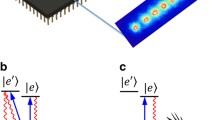Abstract
We present a tutorial review of realizations of quantum computing whichare based on optical manipulations of atoms. Other realizations arebriefly mentioned. The ion trap quantum computer is considered in moredetail as a classical realization of quantum logic.
Similar content being viewed by others
References
Alber G, Beth T, Horodecki M, Horodecki P, Horodecki R, Rötteler M, Weinfurter H, Werner R and Zeilinger A (2001) Quantum information-An introduction to Basic Theoretical Concepts and Experiments. Springer-Verlag, Berlin Heidelberg
Barenco A (1995) Proc. R. Soc. Lond. A 449: 697.
Brennen GK, Caves CM, Jessen PS and Deutsch IH (1999) Quantum Logic Gates in Optical Lattices. Phys. Rev. Lett. 82: 1060–1063
Bouwmeester D, Ekert A and Zeilinger A (eds) (2000) The Physics of Quantum Information-Quantum Cryptography, Quantum Teleportation, Quantum Computation. Springer-Verlag, Berlin Heidelberg New York
Brune M, Nussenzveig P, Schmidt-Kaler F, Bernardot F, Maali A, Raimond JM and Haroche S (1994) From Lamb shift to light shifts: Vacuum and subphoton cavity fields measured by atomic phase sensitive detection. Phys. Rev. Lett. 72: 3339–3342
Cassettari D, Hessmo B, Folman R, Maier T and Schmiedmayer J (2000) Beam Splitter for Guided Atoms. Phys. Rev. Lett. 85: 5483–5487
Chu S (1998) Nobel lecture: The manipulation of neutral particles. Rev. Mod. Phys. 70: 685–706
Cirac JI and Zoller P (1995) Quantum Computations with Cold Trapped Ions. Phys. Rev. Lett. 74: 4091–4094
Cohen-Tannoudji C (1998) Nobel lecture: Manipulating atoms with photons. Rev. Mod. Phys. 70: 707–719
Dekker NH, Lee CS, Lorent V, Thywissen JH, Smith SP, Drndi M, Westervelt RM and Prentiss M (2000) Guiding Neutral Atoms on a Chip. Phys. Rev. Lett. 84: 1124–1127
Duan L-M, Cirac JI and Zoller P (2001) GeometricManipulation of Trapped Ions for Quantum Computation. Science 292: 1695–1697
Jaksch D, Briegel H-J, Cirac JI, Garnider CW and Zoller P (1999) Entanglement of Atoms via Cold Controlled Collisions. Phys. Rev. Lett. 82: 1975–1978
Loss D and DiVincenzo DP (1998) Quantum computation with quantum dots. Phys. Rev. A 57: 120–126
Mabuchi H, Armen M, Lev B, Loncar M, Vuckovic J, Kimble HJ, Preskill J, Roukes M, Scherer A and van Enk SJ (2001) Quantum networks based on cavity OED. pp. 1–6
Maklin Y, Schön G and Schnirman A (2001) Quantum-state engineering with Josephsonjunction devices. Rev. Mod. Phys. 73: 357–401
Monroe C, Meekhof DM, King BE, Itano WM and Wineland DJ (1995) Demonstration of a Fundamental Quantum Logic Gate. Phys. Rev. Lett. 75: 4714–4717
Nielsen MA and Chuang IL (2000) Quantum Computation and Quantum Information. Cambrige University Press, Cambridge
Pellizzari T, Gardiner SA, Cirac JI and Zoller P (1995) Decoherence, Continuous Observation, and Quantum Computing: A Cavity QED Model. Phys. Rev. Lett. 75: 3788–3791
Phillips WD (1998) Nobel lecture: Laser cooling and trapping of neutral atoms. Rev. Mod. Phys. 70: 721–741
Rauschenbeutel A, Nogues G, Osnaghi S, Bertet P, Brune M, Raimond J-M and Haroche S (2000) Science 288: 2024
Sackett CA, Kieplinski D, King BE, Langer C, Meyre V, Myatt CJ, Rowe M, Turchette QA, Itano WM, Wineland DJ and Monroe C (2000) Experimental entanglement of four particles. Nature 404: 256–259
Shor PW (1994) In: Goldwasser S (ed) Proceedings of the 35th Annual Symposium on the Foundations of Computer Science, p 124. IEEE Computer Society Press, Los Alamitos, CA
Sleator T and Weinfurter H. (1995) Realizable Universal Quantum Logic Gates. Phys. Rev. Lett. 74: 4087–4090
Sorensen A, Duan L-M, Cirac JI and Zoller P (2001) Many-particle entanglement with Bose-Einstein condensates. Nature 406: 63–66
Sorensen A and Molmer K (2000) Ion trap quantum computer with bichromatic light. Fortschr. Phys. 48: 811–821
Steane A (1998) Quantum Computing. Rep. Prog. Phys. 61: 117–173
Turchette QA, Hood CJ, Lange W, Mabuchi H and Kimble HJ (1995) Measurement of Conditional Phase Shifts for Quantum Logic. Phys. Rev. Lett. 75: 4710–4713
Vandersypen LMK, Steffen M, Breyta G, Yannoni CS, Sherwood MH and Chuang IL (2001) Experimental realization of Shor's quantum factoring algorithm using nuclear magnetic resonance. Nature 414: 883–887
Author information
Authors and Affiliations
Rights and permissions
About this article
Cite this article
Töormä, P. Realizations of quantum computing using optical manipulations of atoms. Natural Computing 1, 199–209 (2002). https://doi.org/10.1023/A:1016543713037
Issue Date:
DOI: https://doi.org/10.1023/A:1016543713037




